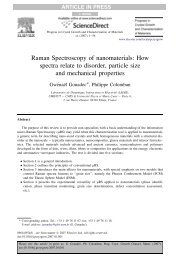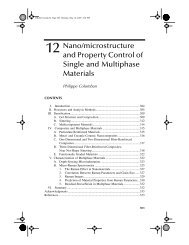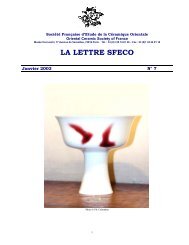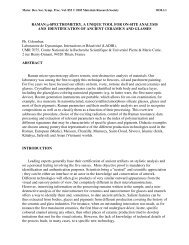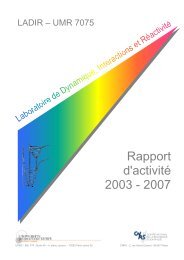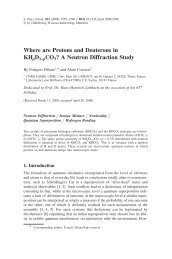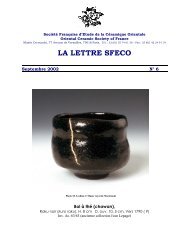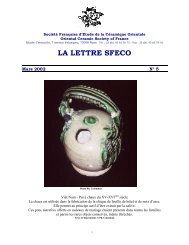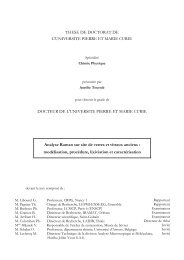Structure and dynamics of the symmetric hydrogen ... - ResearchGate
Structure and dynamics of the symmetric hydrogen ... - ResearchGate
Structure and dynamics of the symmetric hydrogen ... - ResearchGate
Create successful ePaper yourself
Turn your PDF publications into a flip-book with our unique Google optimized e-Paper software.
396( )F. Fillaux et al.rChemical Physics 244 1999 387–403Ž . Ž . Ž Ž ..Fig. 8. Potential function left <strong>and</strong> wave functions right for <strong>the</strong> n OHO mode see Table 6, Eq. 1 .aŽ Table 6 ., in agreement with previous observationsin <strong>the</strong> infrared w19,21 x. This is an example wherefrequency ratios close to unity are not due to adouble-well potential.Intuitively, <strong>the</strong> naOHO spectrum can be picturedas a single transition at 665 cm y1 , due to <strong>the</strong> centralminimum, <strong>and</strong> a doublet at 500–530 cm y1 , due to<strong>the</strong> double minimum. This view is in qualitativeagreement with <strong>the</strong> shapes <strong>of</strong> <strong>the</strong> wave functionsŽ Fig. 8 .: C1 <strong>and</strong> C2are similar to wave functionsfor a double-well potential with minima located at;"0.8 A, ˚ except that <strong>the</strong> anti<strong>symmetric</strong> state isnow below <strong>the</strong> <strong>symmetric</strong> state. C3is largely delocalizedover all three wells. However, in <strong>the</strong> rangespanned by C0it is similar to <strong>the</strong> ns1 state in aharmonic potential.In <strong>the</strong> ground state, <strong>the</strong> proton is fairly welllocalised at <strong>the</strong> center <strong>of</strong> <strong>the</strong> <strong>hydrogen</strong> bond, inagreement with diffraction data. The shape <strong>of</strong> <strong>the</strong>wave function resembles that <strong>of</strong> a harmonic oscillatorat frequency ;670 cm y1 , close to <strong>the</strong> 03transition. It is almost impossible to determine <strong>the</strong>anharmonicity <strong>of</strong> <strong>the</strong> potential function from measurements<strong>of</strong> <strong>the</strong> probability distribution <strong>of</strong> protonsat low temperature Žfor example, neutron diffraction,neutron Compton scattering, etc. . The calculatedmean-square amplitude Ž 0.025 A˚2. compares wellwith <strong>the</strong> temperature factor determined by neutrondiffraction at low temperature Ž 0.016 A˚2in Table 4 ..A major consequence <strong>of</strong> <strong>the</strong> potential shape is <strong>the</strong>Žy1large zero-point energy ;600 cm .. In <strong>the</strong> harmonicapproximation, <strong>the</strong> mean square amplitudeshould be ;0.016 A ˚2. However, <strong>the</strong> very largeanharmonicity spreads <strong>the</strong> wave function across <strong>the</strong>region normally forbidden within classical mechanics.6. Maleate-ring <strong>dynamics</strong>The out-<strong>of</strong>-plane bending <strong>of</strong> <strong>the</strong> maleate ring canbe represented as an anti-rotation <strong>of</strong> <strong>the</strong> CHCOOentities around an axis parallel to <strong>the</strong> C5C bond <strong>and</strong>going through <strong>the</strong> center <strong>of</strong> gravity <strong>of</strong> each residueŽ see Fig. 1a .. This axis is very close to <strong>the</strong> OŽ . 2˚2atoms <strong>and</strong> <strong>the</strong> moment <strong>of</strong> inertia is about 44 amu Afor each entity. The most intense b<strong>and</strong>s at 153, 303,605 cm y1 <strong>and</strong> some weaker b<strong>and</strong>s above 800 cm y1Ž Table 5.are not amenable to ei<strong>the</strong>r harmonic orvery flat Ž square-like.potentials. A <strong>symmetric</strong> doubleminimum potential is also unlikely <strong>and</strong> should beincompatible with <strong>the</strong> crystal structure. Following<strong>the</strong> same line <strong>of</strong> reasoning as for <strong>the</strong> naOHO b<strong>and</strong>s,<strong>the</strong> energy level scheme can be fitted with a tripleminimum potential function Ž Fig. 9 <strong>and</strong> Table 7 ..INS relative intensities calculated assuming <strong>the</strong> Ž C.Hprotons ride <strong>the</strong> HCOO entities are in agreementwith <strong>the</strong> observations Ž see Table 7 ..



